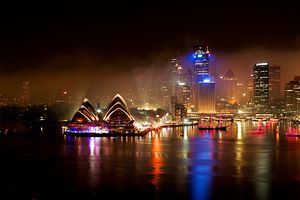Governments in Australia are increasingly becoming concerned with the centralized nature of Australia’s growth. Australia is already one of the world’s most highly urbanized countries, with around 9 million of the country’s 24 million people living in two cities alone (Melbourne and Sydney). However, a report by the Melbourne-based think tank the Grattan Institute highlights that the trends towards urbanization in Australia are only increasing.
According to the research, half of all jobs growth in the country is being concentrated within a 2 kilometer radius of the city centers of Sydney and Melbourne. This is due to the significant growth in service-based industries in the post-industrial economy. Such businesses achieve greater gains when positioned in close proximity to other service providers in densely populated areas. As more growth is created in these sectors, the phenomenon is compounded.
This is creating a sharp divide in the country between a highly enfranchised urban centers, and the declining opportunities of the regions. Australia’s treasurer, Scott Morrison, highlighted this phenomenon when he told The Australian newspaper, “In a large economy like Sydney and Melbourne or southeast Queensland, you can have quite disruptive changes that are occurring, but [the size of] those economies means that people can get to other opportunities.” He added, “But if you go to some parts of the country — and you see what is happening at Hazelwood and Whyalla and Portland and Townsville and so on — the ability to immediately go and do something else is just not there.”
The reality of this opportunity deficit in Australia’s regional towns is not just an economic concern, but is rapidly becoming a political problem for the government and the other major political parties as well. A distinct cultural division has arisen between the comfortable cosmopolitan urban centers and the more parochial and disaffected regions, which are increasingly expressing their discontent through the ballot box.
This is reflected by data in the Grattan Institute report. According to the report, in the most recent Federal election, around 20 percent of people who live within a 10 km radius of their state’s capital city center gave their vote in the Senate to a party other than the governing Coalition, the Labor Party, or the Greens. This phenomenon rose to 30 percent for those more than 100 km away, and 37 percent for those 1,000 km away. This trend also correlates to education and incomes levels that slide the further away from a city center an individual is.
Yet this regional discontentment is not stemming from a lack of government interest in regional Australia. The report highlights that the economic output of Sydney represents around 22 percent of Australia’s total GDP, yet the city was only allocated around 5 percent of federal infrastructure spending in the decade up to 2015. Yet in the same time frame the rest of the state of New South Wales received 27 percent of federal infrastructure funding, despite only accounting for 8 percent of the country’s GDP.
This allocation of infrastructure spending still reflects a country strangely uncomfortable with its urban nature. The public discourse maintains some prominent fretting about its cities becoming “too big,” with the opposition leader in the state of Victoria beginning to actively campaign against Melbourne’s population growth.
There remains a strong sentiment clinging to the country’s national myths, which see “the bush” as the soul of Australia, despite the statistics that prove otherwise. As a young, modern state with an advanced economy (albeit with significant resource and agricultural sectors) Australia hasn’t existed in an era that lent itself to developing strong regional centers with vibrant industries of their own. The gains from proximity that fuel urbanization have been an increasing aspect of human organization since European colonization. That is why Australia has been, and continues to be, one of the most urbanized countries in the world, with almost 90 percent of its population living in cities.
Yet despite being a highly urbanized country, Australia’s cities remain low-density in comparison to other wealthy cities in Europe and to a lesser extent North America. Most new homes are still being built on the urban fringes of the country’s major cities, with strong hostility from the privileged classes to construction in well-serviced areas. Countering this attitude in order to expand access to city centers should be the government’s primary focus, instead of endorsing further sprawl and decentralization.
The concentration of jobs around the city centers of Sydney and Melbourne isn’t a trend that the government can reverse in the private sector, and attempts to move government departments to regional areas also undermines the essential knowledge these departments gain by being close to the action. Furthermore, policies that attempt to push against human demand tend to fail or cause greater problems.
While the romanticism of regional Australia remains strong, in the urban century the trend toward urbanization is only going to increase. A desire to create a more widespread access to opportunity, and to increase the country’s political stability, should lead governments to embrace Australia’s urban nature.

































